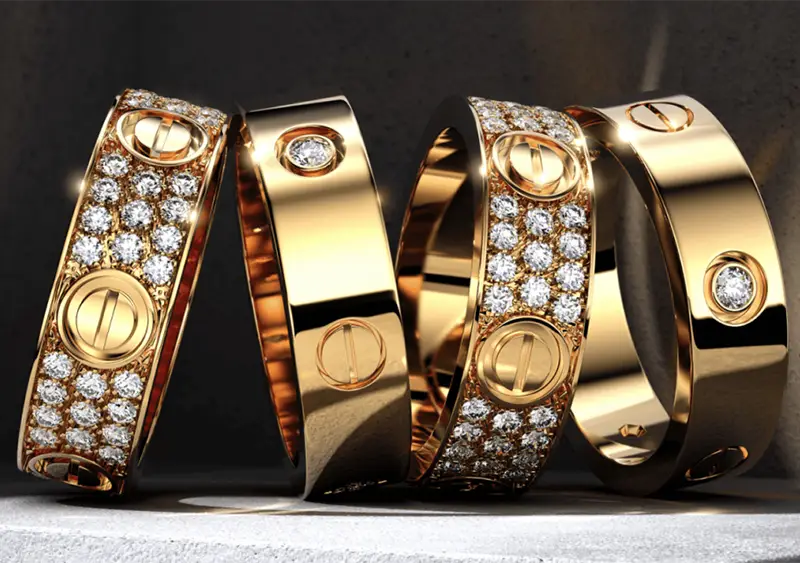Step-by-Step Process: From Sketch to 3D Jewelry Rendering
From sketch to stunning 3D-bring your jewelry to life.

7 MIN READ
May 22, 2025

Written By
Allwyn Ruban
But between that first line and the final customer-ready visual, there’s a whole process that most people never see. A process where creativity meets software, where raw ideas are translated into lifelike visuals so detailed, you can almost feel the metal.
That’s the magic of the 3D jewelry rendering process.
And if you’re a designer, a brand, or even someone commissioning a new collection, knowing how this process works doesn’t just make you smarter. It makes the whole journey smoother. Fewer revisions. Faster approvals. Better results.
So, how does a 2D sketch become a scroll-stopping render? Let’s walk through it. Step by step.
Why You Should Know the Process Before You Render?
Let’s be honest, rendering can feel like a black box.
You send a sketch. A few days later, a render appears. Looks good. But… is it accurate? Was that stone placement intentional? Could the lighting have been better?
Most people accept what they get because they don’t fully understand what happens in between. And that’s the problem.
If you don’t know how the 3D jewelry rendering process works, you can’t guide it. You can’t give better feedback. You can’t spot when something’s off. And worse you end up with visuals that might look okay, but completely miss the soul of your design.
But when you do understand the steps from the first 3D model to material mapping and lighting choices you unlock creative control. You become part of the process, not just a client waiting for updates.
Knowing the workflow helps you:
- Ask smarter questions
- Avoid rounds of back-and-forth
- And get renders that actually match the piece in your head
So, let’s demystify it. Step by step.
Step-by-Step Process Involved in 3D Jewelry Rendering:
Step 1: It All Starts With the Sketch
Every jewelry story begins with a shape.
Sometimes it’s a hand-drawn sketch with uneven lines and a spark of personality. Other times, it’s a full-fledged technical drawing, mapped with dimensions and stone sizes. Either way, this is where intent meets paper (or screen).
But not every sketch is ready to be rendered.
A renderable sketch needs a few essentials:
- A clear sense of proportions (how big is the stone compared to the band?)
- Indications of materials (rose gold? platinum? mixed?)
- An idea of finishes high polish, matte, brushed, or textured
- If possible, multiple angles or reference visuals (even rough ones)
The more context you provide here, the more accurate the final visual becomes. This isn’t about being perfect, it's about sharing what the design is meant to feel like.
Some clients send moodboards. Others, CAD drafts. Some share a photo of an heirloom piece they want reimagined. That’s all valid. What matters is clarity of intention. Because once that’s in place, the 3D jewelry design workflow begins to take shape.
Step 2: Turning Ideas into 3D Geometry
This is where your sketch stops being flat and starts becoming something you can almost touch.
In this phase, designers use specialized software like Rhinoceros, MatrixGold, or ZBrush to create a digital 3D model of your jewelry. Every curve, setting, and surface is built from scratch. It’s no longer just drawing its architecture.
But here's what most people don't realize:
Great 3D modeling isn’t just about copying the sketch. It's about interpreting it with real-world precision. If the band looks too thin in render, it might snap in production. If the prong setting isn’t deep enough, the stone won’t sit properly.
So the 3D artist has to balance creativity with structure. They think about:
- How the piece would sit on the hand or neck
- How shadows will behave in future lighting
- How to build symmetry without killing the uniqueness of the original design
Every decision here affects the final render—and often, the final product itself.
This stage is where design vision becomes tangible form. And if done right, it sets the foundation for everything that follows.
Step 3: Materials, Metals & Gem Mapping
Once the 3D model is ready, it’s time to dress it up.
This is the phase where that bare digital structure gets assigned its identity: gold, platinum, emerald, enamel, brushed titanium whatever your design calls for. This step isn’t just decoration. It’s detailed at the micro level.
The software now maps:
- Metal types: Yellow gold reflects light differently than white gold. Rose gold needs warmth in highlights.
- Gemstones: Cut, clarity, refractive index these affect how light bounces through a stone.
- Surface finishes: Is the band mirror-polished? Satin-matte? Hammered texture? These all need to be built into the material map.
Even the tiniest error like a gemstone that doesn’t catch the light correctly can make the whole piece feel off. That’s why this stage is as technical as it is artistic.
It’s also where you can explore variations without cost:
- Want to try the same ring in three metals? Easy.
- Want to see how it looks with a ruby instead of a diamond? No problem.
Material mapping is where your vision starts to shimmer. Literally.
Step 4: Lighting Setup – The Mood Maker
You can have the perfect model. The right metals. The ideal stone cut.
But without great lighting? It’ll still fall flat.
Lighting is what brings depth, emotion, and realism into the render. It highlights the sparkle of a diamond, the warmth of rose gold, the softness of a brushed finish. Think of it as the mood of the visual. It tells the story of how your product can’t speak out loud.
There are typically two approaches here:
- Studio Lighting: Clean, controlled, high-contrast. Perfect for ecommerce, product sheets, and catalog use. It’s sharp, minimal, and lets the piece shine solo.
- Natural Lighting: Mimics daylight, with soft shadows and natural falloffs. Ideal for lifestyle previews, social media creatives, or brand storytelling.
Setting up lighting isn’t just about putting a “light” in the scene. It’s about angle, softness, reflection, and environment. Even a half-degree tilt in the key light can change how a stone looks too flat, and it’s lifeless. Too harsh, and it’s overexposed.
A seasoned rendering artist knows how to sculpt with light revealing the shape of a ring, emphasizing its depth, and controlling how your customer feels when they see it.
This is the moment your product goes from visible to irresistible.
Step 5: Rendering the Final Output
Now comes the payoff. After modeling, material work, and lighting this is when the scene is locked in, and the final image gets generated.
Rendering is where all the creative and technical inputs are translated into a high-resolution visual. Depending on your needs, that could be:
- A clean white-background image for your product page
- A 4K lifestyle shot for your marketing campaign
- A rotating animation to showcase movement and brilliance
- Or even an AR-ready asset for virtual try-ons
The output format matters too:
- JPEG/PNG for ecommerce and web use
- TIFF for print and packaging
- MP4/GIF for motion previews
- Or layered files for future edits
But rendering isn't just about hitting "export." It's about optimizing for purpose.
Does it load fast enough for mobile users? Is it detailed enough to zoom in on prong settings? Does the color look accurate on different screens?
At ZealousXR, we often render in multiple passes lighting, reflection, refraction, ambient occlusion then composite them for full control. It’s like post-production in filmmaking, but for jewelry.
This is the final step but it’s also your first impression. So it has to be flawless.
What a Good 3D Jewelry Design Workflow Actually Feels Like?
You can follow all the steps. Tick all the boxes. But here’s the truth: the difference between working with a renderer and working with the right rendering partner is in the experience.
The best workflows don’t feel like workflows at all. They feel like creative collaboration.
You send a sketch, and they don’t just nod, they ask smart questions.
You get a first draft, and the lighting already feels like your brand.
You suggest a revision, and they don’t push back, they enhance it.
That’s what good rendering feels like:
- Smooth communication
- Proactive suggestions
- Fewer revisions, faster approval
It’s not just about technical skill. It’s about a process built around your creative goals, your deadlines, your standards.
That’s why so many jewelry designers and retailers now treat their rendering partner like part of their team, not just a service vendor.
Because when the workflow clicks, your launch gets easier, your visuals get stronger, and your vision gets the attention it deserves.
Final Thoughts:
Jewelry was never meant to live in files or folders. It’s meant to sparkle. To move. To stop someone mid-scroll and make them look twice.
The 3D jewelry rendering process isn’t just a technical pipeline, it's your opportunity to show the world what you’ve imagined, before it even exists. It’s how you make the invisible visible.
So if you're designing something special, don’t settle for visuals that just "do the job."
Get renders that make people feel something.
Because in the end, people don’t buy pixels. They buy beauty. Emotion. Presence. And great renders deliver all three.
Got a design that deserves the spotlight? Let’s turn your sketch into something unforgettable with Zealous India.
About the writer :
Allwyn Ruban heads business development and marketing at Zealous Services. He’s the go-to person for finding smart ... ways to grow their 3D services, from animation to modeling. With a knack for digital strategy, Allwyn is all about helping clients achieve their goals while expanding Zealous' reach in the industry. His friendly approach makes collaboration easy and effective.
Read MoreFrequently Asked Questions (FAQ)
Do I need a CAD file to start the 3D jewelry rendering process?
Not necessarily. You can start with a hand-drawn sketch, a photo reference, or even just an idea. A good rendering team can guide you through translating that into a 3D model.
How long does a full jewelry rendering project usually take?
It depends on complexity, but most single-piece projects take 3 to 7 working days from sketch to final render. More complex pieces or animations may take longer.
Can I request changes after seeing the first render?
Yes. Most studios, including ZealousXR, include a set number of revisions. These help refine lighting, materials, or details to get the render exactly how you want it.
What file types will I receive at the end of the project?
Typically, you'll receive high-resolution image formats like PNG or JPEG. If you need assets for print, AR, or animation, you can also request TIFF, MP4, or other formats.
Can the same design be rendered in different metal and gemstone combinations?
Absolutely. One of the biggest benefits of 3D jewelry rendering is flexibility. You can easily visualize the same design in various metal tones or with different center stones.